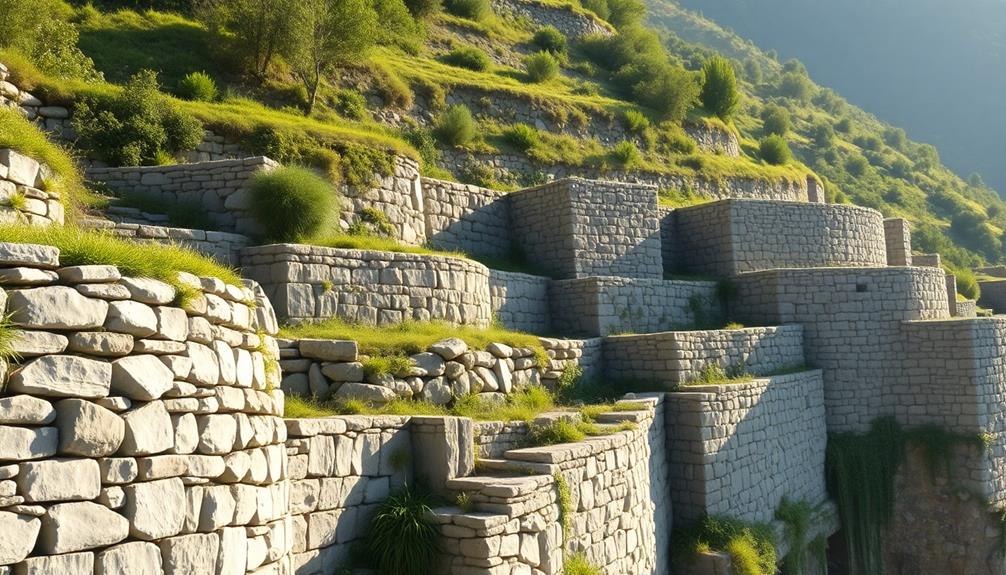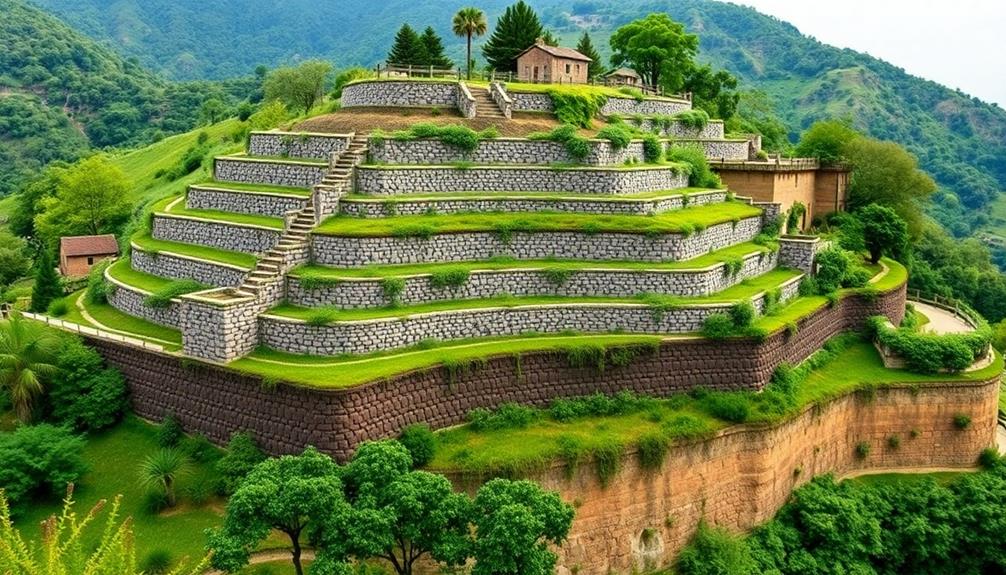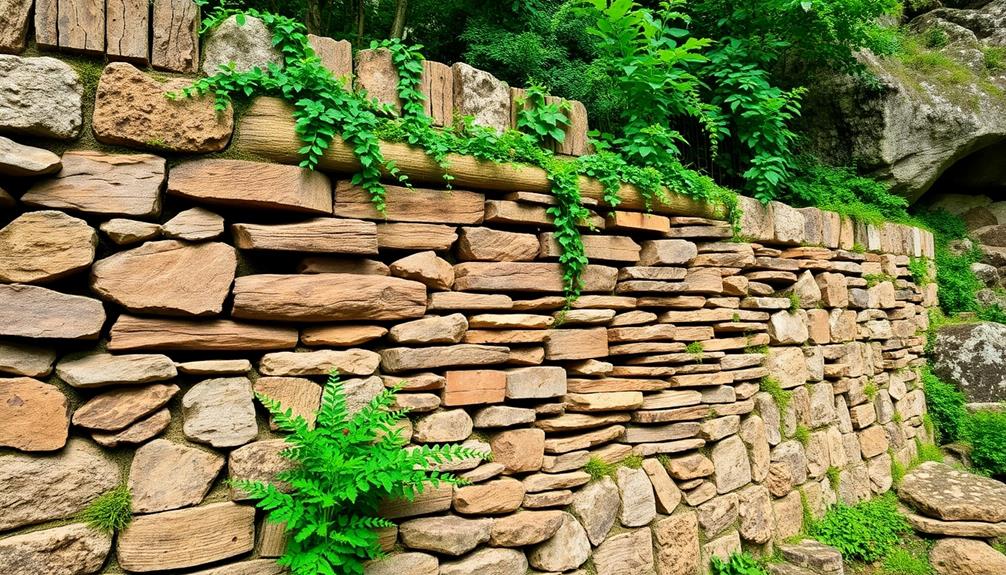The historical evolution of retaining wall construction techniques showcases significant advancements in materials, engineering, and design. Ancient civilizations employed materials such as stone, clay, and timber, advancing from rudimentary stacked stone and mudbrick walls to structurally complex arrangements. Early designs harmonized with natural landscapes and incorporated cultural aesthetics. As understanding of load distribution and materials improved, collaborations between architects and engineers refined these retention systems. Modern techniques utilize robust materials such as reinforced concrete and introduce efficient drainage systems to enhance stability. This evolution continues as contemporary methods further explore innovative materials and designs, offering deeper insights into sustainable construction practices.
Table of Contents
ToggleWalls Contractor Highlights
- Ancient builders used stone, clay, and timber, reflecting environmental adaptations and cultural values in retaining wall construction.
- Early retaining walls featured stacked stones, mudbricks, and timber frameworks emphasizing regional climatic adaptations.
- Structural engineering advancements introduced mathematical principles for load distribution, enhancing retention system efficiency.
- Modern retaining walls incorporate reinforced concrete and geosynthetics for improved stability and erosion resistance.
- Effective drainage solutions and aesthetic designs enhance structural integrity while preserving environmental sustainability and community aesthetics.
Historical Construction Introduction

The history of retaining wall construction is deeply rooted in ancient methods, where building materials such as stone and wood were first employed to establish the foundational structures that protected early civilizations. These initial designs highlighted simple yet effective techniques that focused on using the natural terrain as a support system while marking the beginnings of structural engineering principles.
In more recent times, modern expertise from licensed and insured companies guarantees that retaining walls not only meet building code requirements but also prioritize structural integrity and weatherproofing. As societies evolved, so did the sophistication of these techniques, setting the stage for future innovations in wall construction.
Ancient Building Materials
Rooted in the ingenuity of early civilizations, ancient building materials have laid the foundation for countless architectural marvels throughout history. These materials, both abundant and durable, have provided architects with the tools necessary to shape communities, foster trade, and create resilient structures.
Stone, one of the earliest materials, was revered for its longevity and strength, enabling the construction of formidable edifices such as the Egyptian pyramids and Roman aqueducts. This versatile material was often extracted from local quarries, ensuring a sense of belonging and uniformity within regional architectural styles.
In addition to stone, clay was instrumental in ancient construction, particularly in regions abundant with silt and alluvial deposits. When combined with water and straw, it formed sun-dried or kiln-fired bricks, a material that not only promoted thermal comfort but also allowed for more flexible designs. Timber, another essential material, provided structural support and flexibility in areas where other resources were scarce. Its usage reflects an early understanding of renewable resources and sustainable building practices, underscoring the innovative spirit of these civilizations.
As societies evolved, the integration of these materials into construction methodologies showcased a profound understanding of their properties, foresight into durability, and aesthetic appreciation, all of which resonate in modern engineering practices.
Early Wall Designs
Ancient building materials served as the backbone for innovative early wall designs, where architects and builders employed stone, clay, and timber in creative configurations to meet functional and aesthetic requirements. In exploring these early design methodologies, it becomes apparent that the integration of available materials was central to satisfying both societal and environmental demands. Such ingenuity is evident in ancient construction sites worldwide, reflecting varied climatic adaptations and cultural values, which fostered a sense of community identity and continuity.
The tactile and visual elements of early retaining walls can be vividly conjured through the following features:
- Stacked stone arrangements that echo harmonious alignment with natural landscapes.
- Mudbrick layering techniques tailoring structural solidity in response to regional climate.
- Timber frameworks providing foundational support and flexibility in dynamic environments.
- Embedded decorative elements showcasing cultural symbols and artistic expressions.
- Terraced earthworks offering sustainable land management and aesthetic appeal.
These historic designs were grounded in principles that transcended mere utility, incorporating environmental harmony and societal cohesion, thus achieving a resonance with their surroundings. Through their craftsmanship, these early constructors not only preserved their physical terrains but also fortified a legacy that would guide future generations in the art of wall construction. Each wall extended an invitation for belonging, subtly weaving cultural heritage into the landscapes they protected and adorned.
Structural Engineering Beginnings
At the dawn of structural engineering, a multitude of evolving techniques began shaping the foundation of modern construction practices. Emerging theories and methodologies transformed how structures were perceived, designed, and executed.
Amidst these innovations, the discipline was driven by a necessity for more stable and durable architectural forms. Engineers of the time began to research and implement principles of mathematics and physics to better understand load distribution, force management, and material properties. This era marked the shift from intuitive building approaches to a more systematic and calculated methodology.
Early structural engineers gravitated towards material experimentation and analysis, exploring stone, timber, and emerging metal technologies. Collaborations between architects and engineers became more frequent, fostering a collaborative effort to refine and perfect retention systems like walls.
Retaining walls, instrumental in both urban and rural landscapes, benefitted significantly from these pioneering efforts. This systematic approach allowed for structural designs that were not only efficient but also imbued a sense of unity and cohesion in built environments.
As communities expanded, these innovations conveyed reliability and foresight, offering a semblance of security and progress. Understanding the genesis of these practices fosters an appreciation for the evolution of construction techniques that continue to underpin today's structural endeavors.
Benefits

The construction of retaining walls offers several key benefits that profoundly contribute to both functionality and aesthetics. Enhanced structural stability is paramount, as these walls prevent soil erosion and landslides, while their design integrates improved drainage solutions to manage water flow and reduce hydrostatic pressure.
With the aid of shoreline restoration, retaining walls can also protect property from environmental factors. Additionally, the availability of various aesthetic design options and cost-effective material choices further enriches their appeal, allowing for versatile applications across diverse terrains and settings.
Enhanced Structural Stability
Withstanding the test of time, well-engineered retaining walls offer enhanced structural stability, becoming an integral feature in landscape design and construction. These steadfast structures are more than functional barriers; they are symbols of resilience, substantially contributing to the safety and longevity of landscapes. Enhanced structural stability in retaining walls is achieved through a combination of innovative design and material selection, which provides essential support against natural forces and topographical challenges.
Key factors contributing to the enhanced stability of retaining walls include:
- Robust Material Selection: Utilization of high-quality materials like reinforced concrete and geosynthetics that guarantee durability and strength.
- Interlocking Systems: Implementation of interlocking blocks or panels to distribute weight evenly and prevent shifting.
- Anchoring Techniques: Integration of advanced anchoring systems to maintain wall positioning against lateral earth pressures.
- Load Distribution: Consideration of loads and stresses through detailed engineering analysis for optimized wall design.
- Erosion Resistance: Focused design elements that mitigate erosion, such as increased base width or slope stabilization features.
For communities and individuals seeking security and cohesiveness in their environments, understanding and investing in these state-of-the-art retaining wall techniques is paramount. They not only protect but also enhance the aesthetic and functional value of surrounding areas, fostering a sense of belonging and peace of mind.
Improved Drainage Solutions
Effective drainage solutions in retaining wall construction frequently play a pivotal role in maintaining the wall's integrity and longevity. As water accumulation is one of the primary challenges that can compromise the structural foundation of these walls, integrating efficient drainage mechanisms guarantees that hydrostatic pressure is minimized, consequently safeguarding against potential failures.
By utilizing systems such as perforated drain pipes, gravel backfill, and geotextile fabrics, modern retaining walls effectively redirect water away from the structure, preventing erosion and soil destabilization.
Incorporating such drainage solutions fosters a sense of confidence within communities that embrace robust infrastructure as a cornerstone of their environment. These systems not only protect the structural integrity of walls but also contribute to environmental sustainability by preventing waterlogging and promoting natural water drainage patterns.
The benefits extend beyond the immediate structural advantages, engendering a broader appreciation of long-term community safety, especially in regions prone to heavy rainfall. The integration of effective drainage solutions ultimately empowers communities by preserving shared spaces, landscapes, and pathways, assuring they remain functional and accessible.
As a result, retaining wall projects that prioritize drainage solutions reflect a commitment to excellence and foresight, nurturing a collective sense of security and belonging.
Aesthetic Design Options
Beyond ensuring structural integrity through improved drainage solutions, retaining wall projects can also embrace aesthetic design options that elevate their visual appeal. These options not only serve a functional purpose but also contribute to an enhanced sense of belonging for the space they adorn. Thoughtfully designed retaining walls have the power to transform landscapes into harmonious extensions of their environment, offering beauty while performing their essential role.
Natural Stone Textures: Imitating the raw elegance of nature, these textures imbue areas with timeless character and warmth.
Terraced Designs: Layered formations introduce depth and complexity, fostering a welcoming landscape with multiple vantage points.
Vertical Gardens: Infuse life and vibrancy using greenery, making walls feel alive, and encouraging community interaction with the environment.
Artistic Finishes: Custom surface treatments deliver unique identities—be they modern minimalism or rustic heritage—telling stories of place.
Lighting Accents: Subtle illumination enhances nighttime visibility and safety, creating an inviting ambiance for social gatherings.
Such aesthetic elements not only beautify but also personalize spaces, fostering a deeper connection amongst inhabitants and visitors alike. Each design choice fortifies the narrative of the space, confirming that retaining walls can be more than utilitarian structures; they can be eloquent expressions of style and identity, welcoming all who behold them.
Cost-Effective Materials Choices
When planning a retaining wall, selecting cost-effective materials plays a pivotal role in achieving both budget goals and structural efficiency. The choice of materials not only affects the initial investment but also impacts long-term maintenance costs, durability, and sustainability. Concrete blocks, often favored for their versatility and strength, provide a balance between cost and functionality, ensuring the wall endures environmental pressures without frequent repairs.
Using recycled materials, such as reclaimed timber or repurposed stone, can considerably reduce expenses while promoting sustainability—a value increasingly treasured within communities. Such choices forge connections among environmentally conscious individuals and those who value resourcefulness, reinforcing a sense of belonging.
Modular wall systems have emerged as a practical solution; their ease of assembly and reduced labor requirements make them an economical option. Their uniform construction allows for consistent performance and appearance, fostering a feeling of cohesion among homeowners and developers alike.
Incorporating locally sourced materials can further drive down costs by minimizing transportation expenses, while simultaneously supporting local businesses. This commitment to integrating accessible resources resonates with communities, strengthening relationships and fostering a collective identity rooted in practical, thoughtful decision-making.
Common Material Discoveries Utilized

The evolution of retaining wall construction materials has witnessed significant advancements, beginning with ancient stone foundations, which provided durability and robust structural integrity, to the strategic use of timber that allowed for more agile and aesthetically flexible designs, and further advancing to modern concrete innovations, which offer enhanced strength and versatility in contemporary applications. In particular, these materials continue to be instrumental across various terrains and are selected based on factors such as cost-effectiveness, environmental impact, and the specific requirements of the project at hand. The table below illustrates key aspects of these materials and their impact on retaining wall construction:
| Material Type | Key Characteristics |
|---|---|
| Ancient Stone | High durability, weather-resistant, visually timeless |
| Timber | Flexible design, eco-friendly, relatively easy to install |
| Modern Concrete | High strength, versatile usage, durable under stress |
| Material Selection | Depends on cost, environment, project demands |
These developments in material utilization not only reflect the industry's adaptability to changing needs but also highlight the ongoing significance of material choice in optimizing retaining wall construction for diverse scenarios.
Ancient Stone Wall Foundations
Although construction techniques have evolved profoundly over the centuries, the fundamental principles of stone wall foundations have roots deeply embedded in ancient practices. The craft of erecting enduring stone structures can be credited to the ancients who meticulously selected natural resources that guaranteed durability and strength over time. In their wisdom, they recognized the unparalleled stability offered by these materials, forming the backbone for modern-day retaining wall construction.
The ancient builders skillfully harnessed the following key materials for foundation construction:
- Rubble stones provided weight and resilience, effectively stabilizing the edifices against soil pressure.
- Natural bedrocks, serving as a robust base, ensured that the walls remained steadfast through environmental shifts.
- Mortar compounds, derived from lime and volcanic ash, bound stones together with tenacity, preventing displacement.
- Granite blocks, valued for their density and decay resistance, fortified structures built to withstand the propensity for erosion.
- Basalt stones, with inherent strength, proved ideal for walls requiring enhanced load-bearing capabilities.
These foundational elements were both a physical and symbolic connection to a bygone era, where human ingenuity met nature's gifts. This inseparable bond informs not only the practicality of today's stone wall construction but also evokes a sense of belonging to a shared human heritage.
Timber Usage in Retaining
Frequently embraced for its versatility and aesthetic appeal, timber has gained prominence as a material choice in modern retaining wall construction. This ancient material, cherished for its natural beauty and environmental friendliness, serves as a functional ally in creating structures that harmonize with their surroundings. Timber's adaptability in diverse architectural styles aids in enriching the bond between human creations and the environment, promoting a sense of aesthetic cohesion.
Timber offers various benefits in retaining wall applications, including ease of sourcing and the feasibility of personalized design implementation. Treated timber, in particular, provides enhanced durability by resisting rot and insect damage, which extends the lifespan of the structures. Furthermore, its relatively lightweight nature reduces site disturbance, allowing for simpler, more sustainable construction processes. This characteristic proves advantageous in areas sensitive to environmental impact or where minimal intrusion is required.
Additionally, the utilization of renewable timber resources contributes to sustainable practices and eco-friendly construction over time. As the construction community continues to embrace green technologies, timber remains a quintessential material linking traditional craftsmanship with contemporary sustainability. This alignment guarantees that communities are not only aesthetically enhanced but ecologically responsible, effectively fostering a collective sense of belonging and environmental stewardship.
Modern Concrete Innovations
In what ways have modern concrete innovations transformed retaining wall construction? The turn of the century has ushered a paradigm shift in materials used, with concrete innovations playing a pivotal role. Engineered for strength and adaptability, concrete today offers unprecedented durability and resilience, shaping the future of retaining wall construction. Incorporating new additives and mixed designs has enabled structures to withstand both time and nature's wrath. What emerges is a meticulous blend of creativity and engineering, presenting concrete as a stalwart material of construction.
Innovations have introduced:
- Hallmark: Integrating fibers has enhanced concrete's tensile strength, reducing the need for excessive reinforcement bars.
- Proof: Embedded capsules that release healing agents when cracks form, extending the lifespan of structures.
- Emblem: Prefabricated lightweight solutions that minimize the overall weight without compromising strength.
- Signature: A sustainable alternative with reduced carbon footprint, appealing directly to environmentally-conscious builders.
- Insignia: Optimized for specialized projects requiring high strength and durability for innovative architectural designs.
These advancements cater to a deep-seated need for belonging within the construction community, fostering sustainable and innovative growth, and serving as a symbol to the transformative power of modern concrete in retaining wall evolution.
Walls Contractor FAQ
What Are the Main Causes of Early Retaining Wall Failures?
Early retaining wall failures often stem from inadequate drainage, poor design, improper materials, and insufficient foundation support. Addressing these factors collaboratively fosters a sense of unity and advances in our collective approach to sustainable construction practices.
How Did Retaining Wall Designs Evolve With Advances in Mathematical Modeling?
Advancements in mathematical modeling have refined retaining wall designs through precise load analysis, enabling engineers to predict and mitigate potential failures. This evolution fosters community safety and trust in civil engineering, enhancing belonging in infrastructure reliance.
Who Were Notable Engineers That Revolutionized Retaining Wall Construction Techniques?
Remarkable engineers like Karl Terzaghi, known as the "father of soil mechanics," substantially advanced retaining wall construction. Other pioneers include Eugene Freyssinet and Alexandre Collin, who introduced innovative techniques that transformed engineering practices universally.
What Impact Did Cultural Differences Have on Historical Retaining Wall Designs?
Cultural differences markedly influenced historical retaining wall designs through distinct aesthetic preferences, material availability, and engineering approaches. These variations fostered a sense of identity and belonging within communities, reflecting local values and environmental adaptability in construction practices.
How Did Sustainable Construction Methods Influence Retaining Wall Innovations?
Sustainable construction methods have greatly influenced retaining wall innovations by introducing eco-friendly materials and practices that enhance durability and reduce environmental impact, fostering a sense of community responsibility and environmental stewardship among construction professionals and stakeholders.







